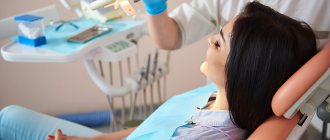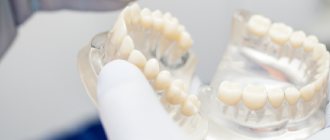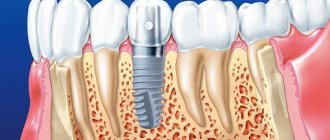Dr Reena Wadia, a dentist practicing in London, shares some advice in this video for colleagues who would like to introduce dental photography into their work. Rina considers both the need for photography in dentistry and purely practical aspects: what you need to get started, how to set up a camera for certain angles. A quick guide for beginners to quickly introduce dental photography into practice.
Subscribe to our YouTube channel: Channel of the dental portal Stomanet.ru
Tips regarding logistics begin at the 46th second of the video, questions about camera settings start at the 3:19 mark. In general, Rina recommends the following.
- Camera type: SLR, single lens reflex camera. excellent image quality, optimal use of light, the ability to shoot at short distances and set settings manually.
- If you are taking a camera only for dental photography, the body (“body”) does not matter much.
- The critical component is the lens. It should allow you to take pictures at close range (macro photography).
- The mouth is very dark, so dental photography is indispensable without flash. It is recommended to use a ring flash as it allows you to get a clear photo without shadows.
- You will also need: a memory card, spare batteries, a camera bag in which you can put everything you need.
- Other accessories – retractors, mirrors and contrasters.
Camera settings for taking pictures of teeth (dental photography)
- Under your control is the diameter of the hole in the diaphragm through which light enters the matrix and captures the image on it. The diameter is called “aperture” or “focal number” (f-number). The lower the focal number, the larger the hole diameter. As the focal number increases, so does the depth of field. Recommended focal number values: — shooting a face — f8; — shooting lips and teeth — f13-16; — shooting inside the oral cavity — f22-29.
- Set ISO (light sensitivity) to 100 or 200,
- Shutter speed - 1/160,
- White balance - automatic or "flash".
The path to professional dental photography. Thomas Henninger. Part I
The path to professional dental photography
Thomas Henninger (part 1)
A good dental photograph is not determined by the price at which the camera is purchased. Moreover, the use of certain techniques and aids can determine whether a photo looks professional or not. Dental photography is generally characterized as demanding. Along with the problem of depth sharpness, the pitfalls of macro photography also include the difficult situation with lighting in the oral cavity. Naturally, here too a certain amount of practice makes a master. To ensure that you are best equipped to perform successful dental photography, I will cover in this article and the next part the criteria for purchasing a camera and introduce several techniques and aids.
As a dental lighting specialist, I face daily questions: “Can I take good dental photos?” or “Which camera is the best?” But the answer to the question “Which car is the best?” depends on individual requirements and cannot be answered in one sentence. I will be happy to describe further a situation where a doctor, who had professional equipment for 4,000 euros, during one of my photography courses looked with envy at his neighbor in the course, who, with the help of his compact camera for 300, - euros, took significantly better pictures. This example shows that the cost of purchasing a camera is not the same as the quality of the images. On the contrary, it is compact cameras that, due to their small lens diameter, provide very good depth sharpness. The “Law of Optics” says: the smaller the lens diameter, the better the depth sharpness. From this perspective, a small lens on a compact camera can outperform a large DSLR lens in depth sharpness. (ill.1) There are other arguments in favor of compact cameras.
Ill.1. On the left is an unsharp shot with a DSLR camera, on the right is a shot with a compact camera.
Weight
The camera in dental photography must be equipped with an appropriate lighting or flash system. A ring light system for compact cameras is significantly lighter than a ring light or flash system for a DSLR camera. In addition, to take photographs with a SLR camera, you usually need a 100x macro lens, which adds 600 grams of weight to the system alone. When it comes to weight, a small compact camera definitely beats a DSLR camera.
Convenient use
Overall, the camera should fit well in your hand. Just as we differ from each other, so do the camera models on the market. An unambiguous recommendation is impossible - tests must be carried out. It is necessary to pay attention to the fixation of the lighting system or flash. Manufacturers fix classic flash systems using a “hot shoe” and significantly shift the camera’s center of gravity. Therefore, the use of the camera must first be tested with all attachments, as it will later be used in everyday practice.
Permission
Both compact models and existing DSLR models have a resolution of approximately 10 megapixels. For everyday standard documentation, this is almost too good. If the photo is enlarged to poster format, 4 to 6 megapixels is usually enough to get good quality. A common misconception is wanting high resolution so that you can project the images greatly enlarged on the wall during presentations and training. But the quality here does not depend on the resolution of the camera or computer, but only on the projector, in other words, on the video projector. And the latest high-definition digital TV (HDTV) devices can provide relatively low resolutions. For a camera like HDTV 720p, this is 1280 x 720 or 0.9 megapixels, and even for HDTV with 1920 x 1080 pixels, the resolution is only about 2 megapixels (Table l). Nothing will change in this and the foreseeable future. This means that for a 10 m wide projection at Audiomax, camera images from 3 megapixels will be quite sufficient.
Of course, a new acquisition must comply with the existing state of the art and always have reserves, for example if a certain detail in a survey photograph needs to be enlarged. For everyday documentation, it makes sense to reduce the camera's maximum resolution. This saves, in addition to memory space and processing time, also time during transfer, especially when the image must be sent by E-mail without preliminary processing using a separate program.
| Device | Permission | Norm |
| Intraoral camera | 0.4 megapixels | PAL |
| TV picture | 0.4 megapixels | PAL |
| Computer monitor | 0.5 megapixels | SVGA |
| Computer monitor | 0.8 megapixels | XGA |
| TV picture (future) | 0.9 megapixels | HDTV 720p |
| TV picture (future) | 2 megapixels | HDTV 1080i |
| Digital camera | 8 - 12 megapixels | |
| Table 1: Comparison of the resolution of various devices that produce images | ||
The larger the matrix, the better the digital camera
A digital camera has an electronic sensor (sensor) instead of film, which takes incoming light and turns it into a digital photo. Digital SLR cameras typically have larger sensors due to the larger lens diameter. This has a positive effect on the light sensitivity of the camera chip. If individual pixels are packed too tightly together on a small chip, this will cause skipping of charges at high gain. When taking pictures under poor lighting conditions, this effect appears as noise in the picture. In simple terms, this means: a large sensor begins to make noise later in low light.
Considering space and cost, a compact camera will generally have a smaller sensor. On the contrary, a digital SLR camera is usually equipped with a larger sensor and therefore produces high-quality images even in poor lighting conditions. But since during dental photography we still use an additional flash or constant light, this drawback is less pronounced.
DSLR vs Compact
When asked, “Which is better, a DSLR or a compact camera?” the photographer would constantly answer, “Of course, mirrored.” There are several reasons for this. One of them relates to the “analogous world”, when compact non-DSLR cameras were completely unsuitable for dental photography. This was due to something called parallactic misalignment, which occurred when an object was too close in front of the camera lens. If you look through a search engine, the visible image is constantly shifted to the side relative to what was visible through the lens or was then displayed on film. Camera designers simply assumed that the subject was usually at least two meters away from the camera. The consequence of this was that the photographer could never be sure which part of the picture he was photographing.
Today, the argument regarding parallactic displacement is no longer relevant: the image that appears on the display of a digital compact camera always exactly matches its version on the sensor and, therefore, the picture that is then visible in the image. Moreover, compact cameras have an advantage over most DSLR models, namely, they show a live image on the display. In a DSLR camera, the sensor is covered with a mirror, which is due to the design, due to which the picture appears on the camera display only after shooting. Thus, in most cases the photographer is forced to look through an optical search engine, which again affects the ergonomics in the photographer’s workflow (Fig. 2 and 3).
Ill. 2 and 3: An example of ergonomics when working with a DSLR (left) and a compact camera (right).
A digital compact camera also has the advantage that in several models the display can be flipped horizontally (Fig. 4)
Ill. 4 Compact camera with movable display.
This feature proves to be very practical for images of the upper and lower jaw. And the ability to remain in eye contact with the patient during the image is perceived by the user as convenient. Thus, weight and ease of use, as well as ergonomics, speak in favor of a compact camera.
The undeniable advantage of mirror technology is the clarity of the image in the search engine, despite the lack of ergonomics. It is even suitable for determining depth sharpness. However, in everyday practice this is not generally required. The defining thing for a photographer is to shoot quickly and easily. A medical practice is not a photography studio. It's more about working quickly (the motto is: aim, press a button and the result should be good) and making sure that any team can take pictures. The autofocus function in modern cameras has developed so much that, if used correctly, there is great confidence that the pictures will be sharp.
Find the right sharpness
There is one trick to help with problems with dental photographs that are not sharp enough. Most cameras come from the factory with settings when
The level of sharpness is determined independently based on contrast indicators. This is completely unsuitable for occlusion overview shots, for example. In most cases, the sky is reflected very clearly/sharply, and the dentition, the main purpose of the image, is practically invisible. In almost all camera models it is possible to change this autofocus setting. If instead of the “auto” option you select “middle” (central), the camera will from now on sharply reflect the fragment located exactly in the center. This is usually indicated by a small square in the center of the display. The trick is to use this marking to precisely mark a point that should later be sharp in the picture. Then you can only press the start button lightly, without pressing too hard, so that the camera only adjusts the sharpness, but the shooting still starts. The sharpness setting is in most cases determined by the green border of the square. Then the exact fragment of the image is selected, this is how the subsequent image should look. It is important that your finger remains on the half-pressed shutter button. Only when the part of the photo matches your desires should you press the button all the way to take a photo. Provided there is sufficient lighting, this technique guarantees dental images with stable sharpness.
And if many things speak in favor of a compact option, a DSLR camera system may, of course, also be advisable. For example, if the photographer already has similar equipment with many (expensive) lenses. Or in private life he likes to walk in the mountains and for this he often needs a very good telephoto lens. Or he likes landscape shots with extreme angled areas. In this case, it is advisable to purchase an appropriate digital camera in order to be able to continue using existing lenses. However, attention should be paid to the apparent lengthening of the focal length in analog lenses.
Ideal matrix
It would be ideal if the matrix had the format of a transparencies or a small-format photograph. But these full-format matrices are very expensive and therefore are available only in the best models of some manufacturers. Typically, chips are smaller than small format snapshots. Analog lenses are designed for small format or full format images, however, they can be combined with smaller matrices without any problems. But in this case the focal length of the lens changes. Therefore, the technical specifications of a digital SLR camera always indicate an extension of the focal length. Using this extension, the effective focal length can be calculated by simply multiplying the focal length of the lens by a factor. With one and a half lengthening of the focal length and a 100-macro lens, the same fragment of the image is obtained as with a focal length of 150 mm in a small format photograph. The corner zone of the lens is, as it were, limited and the telescopic effect is enhanced.
The following table contains the current advantages and disadvantages of DSLR and compact cameras, with + meaning “good”, ++ “very good”, +++ “very good and only possible here”, (+)* depending on the model and not good or impossible.
| SLR camera | Compact camera | |
| Weight | — | ++ |
| Depth Sharpness | + | ++ |
| Ergonomics | + | ++ |
| Live picture display | + | ++ |
| Folding display | — | +++ |
| Optical search engine | ++ | — |
| In the macro zone, variable focal length | + | +++ |
| Interchangeable lenses | +++ | + |
| Image quality | ++ | + (+)* |
| Characteristics of "noise" | ++ | + |
| Delayed start for photographers. | ++ | + (+)* |
| Price | + | ++ |
Author: Thomas Henninger
Doctorseyes









